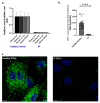A Homozygous Deep Intronic Variant Causes Von Willebrand Factor Deficiency and Lack of Endothelial-Specific Secretory Organelles, Weibel-Palade Bodies
- PMID: 35328514
- PMCID: PMC8950443
- DOI: 10.3390/ijms23063095
A Homozygous Deep Intronic Variant Causes Von Willebrand Factor Deficiency and Lack of Endothelial-Specific Secretory Organelles, Weibel-Palade Bodies
Abstract
A type 3 von Willebrand disease (VWD) index patient (IP) remains mutation-negative after completion of the conventional diagnostic analysis, including multiplex ligation-dependent probe amplification and sequencing of the promoter, exons, and flanking intronic regions of the VWF gene (VWF). In this study, we intended to elucidate causative mutation through next-generation sequencing (NGS) of the whole VWF (including complete intronic region), mRNA analysis, and study of the patient-derived endothelial colony-forming cells (ECFCs). The NGS revealed a variant in the intronic region of VWF (997 + 118 T > G in intron 8), for the first time. The bioinformatics assessments (e.g., SpliceAl) predicted this variant creates a new donor splice site (ss), which could outcompete the consensus 5′ donor ss at exon/intron 8. This would lead to an aberrant mRNA that contains a premature stop codon, targeting it to nonsense-mediated mRNA decay. The subsequent quantitative real-time PCR confirmed the virtual absence of VWF mRNA in IP ECFCs. Additionally, the IP ECFCs demonstrated a considerable reduction in VWF secretion (~6% of healthy donors), and they were devoid of endothelial-specific secretory organelles, Weibel−Palade bodies. Our findings underline the potential of NGS in conjunction with RNA analysis and patient-derived cell studies for genetic diagnosis of mutation-negative type 3 VWD patients.
Keywords: ECFCs; Weibel–Palade bodies; angiopoietin-2; deep intronic mutation; next-generation sequencing; von Willebrand disease; von Willebrand factor.
Conflict of interest statement
The authors declare no conflict of interest.
Figures





References
-
- James P.D., Connell N.T., Ameer B., Di Paola J., Eikenboom J., Giraud N., Haberichter S., Jacobs-Pratt V., Konkle B., McLintock C., et al. ASH ISTH NHF WFH 2021 guidelines on the diagnosis of von Willebrand disease. Blood Adv. 2021;5:280–300. doi: 10.1182/bloodadvances.2020003265. - DOI - PMC - PubMed
MeSH terms
Substances
LinkOut - more resources
Full Text Sources
Molecular Biology Databases
Miscellaneous

